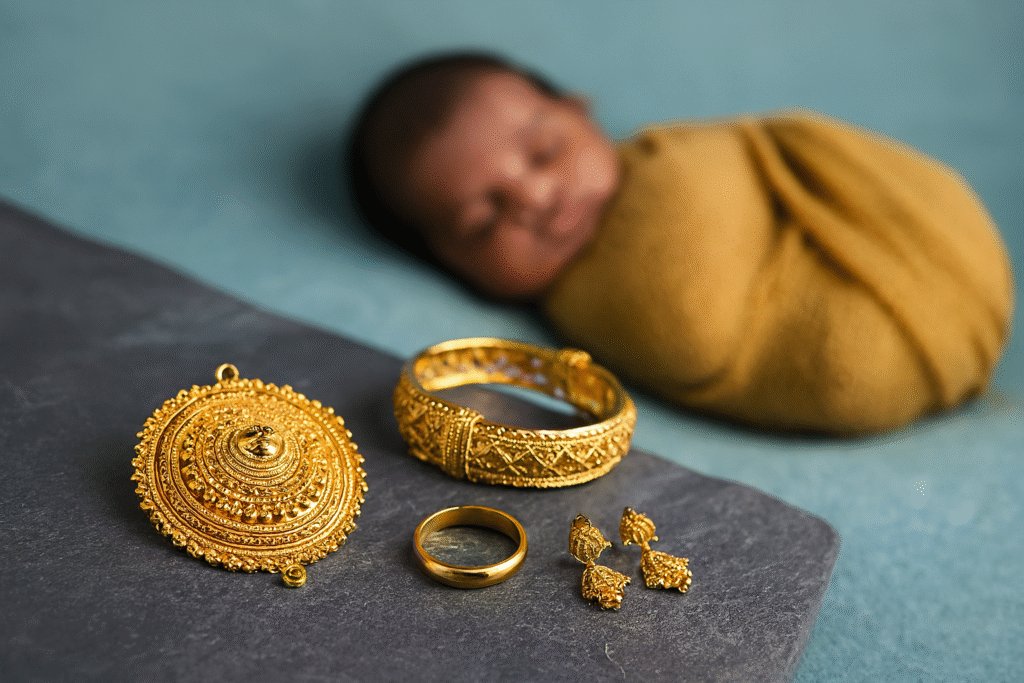Why Buying Gold for a Newborn in Kerala Matters
Buying gold for a newborn in Kerala is more than a gift. It is a tradition deeply tied to family, culture, and blessings. Parents usually choose bangles, chains, or an Aranjanam. But not every design is safe. Many families unknowingly make choices that can harm the baby. In this guide, I’ll explain the three biggest mistakes and show you how to choose jewellery that is safe, practical, and meaningful.
Mistake 1: Choosing Jewellery with Sharp Edges When Buying Gold for a Newborn in Kerala
A newborn’s skin is soft and sensitive. Even a small edge on a bangle can cause scratches or bleeding. In my 40+ years of experience, I’ve seen families return distressed because a “beautiful” design hurt their baby. The key is simple: always check ornaments for smooth finishes. If it scratches your finger, it is not safe for a newborn.
For more guidance, read my Gold Buying Checklist for Malayalis.
Mistake 2: Buying Tight Ornaments for Newborns in Kerala
An Aranjanam that fits snugly may look elegant, but it can reduce blood flow. Medical studies show that 20% of jewellery-related infant emergencies involve circulation issues (NCBI). Always choose adjustable designs and leave room for growth.
To understand why Aranjanam carries cultural importance, explore the post on the Cultural Meaning of Aranjanam in Kerala.
Mistake 3: Choking Hazards in Baby Jewellery in Kerala
Charms, beads, and dangling parts may seem attractive, but they can be deadly. Research shows 14% of choking incidents in infants under one year are linked to small accessories (World Gold Council). Always pick plain, sturdy ornaments.
For assurance about purity and safety, see Understanding BIS Hallmark in Jewellery.
Safe and Practical Gold Jewellery Options for Newborns in Kerala
- Rounded bangles with smooth edges
- Adjustable waist chains (safe Aranjanam)
- Lightweight, plain pendants
Not sure which gold type is best? The guide on 24K vs 22K vs 18K Gold Explained covers everything you need to know.
Expert Advice for Buying Gold for a Newborn in Kerala
In my decades of work in gems and jewellery, I’ve advised many families. The key is this: safety comes before weight or style when buying gold for a newborn in Kerala.
For more design inspiration, see Safe Jewellery Designs for Children.
FAQ
Q1: Can newborns wear earrings immediately?
No. Wait at least six months and consult a doctor.
Q2: How much gold should I buy for a newborn in Kerala?
Traditionally, families buy 2–4 grams. Focus on safe design over weight.
Q3: Which designs are best for daily wear?
Smooth bangles, adjustable waist chains, and plain pendants.
Q4: Should I choose 22K or 24K gold for newborn jewellery?
22K gold is the best balance between purity and durability.
India Regional Cultures: A Complete Diversity Guide
India regional cultures are as diverse as its landscapes. This guide explores traditions, languages, and unique identities across the country. India Speaks FAQ on regional cultures reveals remarkable diversity across the subcontinent. Each state tells a unique story of tradition, heritage, and identity.
This India Speaks FAQ on regional cultures explores how geography, history, and local customs shape the cultural differences across India’s states and territories.
Understanding these regional differences helps you appreciate India’s true cultural richness.
What Makes India’s Regional Cultures Unique?
Each state develops its own distinct language, cuisine, and customs over centuries. Local history shapes traditions and daily life. Geography influences everything from clothing styles to building designs and lifestyle choices.
Examples of regional adaptation:
- Kashmir’s wooden homes with sloped roofs handle heavy snowfall
- Kerala’s houseboats work perfectly with extensive waterways and monsoon climate
- Rajasthan’s thick-walled buildings stay cool in desert heat
These regional adaptations show how different communities respond to their environment while keeping cultural identity.
How Do Regional Foods Reflect India’s Cultural Diversity?
Regional cuisine connects directly to local climate and crops. Coastal regions favor rice cultivation and seafood preparation. Northern states rely on wheat-based breads like roti, naan, and paratha.
Cooking methods vary significantly across regions:
- Mustard oil dominates Bengali cuisine
- Coconut oil is essential in Kerala cooking
- Ghee remains the preferred fat in Rajasthani dishes
When you travel across India, pay attention to these culinary differences. They reveal stories about the land, climate, and cultural preferences. India Speaks FAQ on regional cultures shows these food traditions matter.
Why Are Languages Central to Regional Identity in India?
India speaks through 22 official languages and hundreds of regional dialects. Each language carries unique cultural meaning. Language shapes traditional songs, folk tales, religious festivals, and social customs.
Language examples and their cultural significance:
- Tamil expresses the rich Dravidian heritage of South India
- Punjabi reflects Sikh traditions and agricultural lifestyle
- Bengali carries the literary legacy of Nobel laureate Rabindranath Tagore
- Hindi serves as a connecting language across northern states
Learning even a few local words helps you connect with regional communities. It shows respect for local culture.
What Role Do Festivals Play in India’s Regional Cultures?
Festivals serve as powerful expressions of regional identity. They bring communities together through shared traditions and celebrations. Each region celebrates differently based on local customs, crop cycles, and religious practices.
Regional festival examples:
- North India illuminates Diwali with millions of oil lamps and fireworks
- South India honors Pongal with harvest rituals celebrating farmers and nature
- West Bengal transforms during Durga Puja with art installations, classical music, and community feasting
Each festival reflects the unique cultural values and historical experiences of its region.
Which festival would you want to experience firsthand?
How Does Traditional Clothing Vary Across Indian Regions?
Climate conditions and available resources influence regional clothing styles across India. These variations demonstrate practical adaptation to different environments while maintaining aesthetic preferences.
Regional clothing examples:
- Rajasthan’s desert climate inspires bright turbans, flowing skirts, and mirror-work textiles that reflect heat
- Kerala’s humid tropical climate favors white cotton sarees with golden borders worn during festivals
- Nagaland’s mountainous terrain produces distinctive shawls featuring tribal symbols and geometric patterns
Each style represents clan identity and cultural heritage specific to its region.
How Do Regional Crafts and Arts Represent Cultural Identity?
Traditional crafts carry centuries of accumulated skill and cultural meaning. They serve as living expressions of regional identity. These art forms express creativity through traditions passed down through generations.
Regional craft examples:
- Bihar’s Madhubani paintings feature mythological themes and geometric patterns created by women during festivals
- Kerala’s Kathakali dance combines dramatic storytelling, classical music, and elaborate costumes
- Odisha’s traditional metalwork, particularly brass and bronze artifacts, carries deep ritual meaning in temple worship
Supporting these regional crafts helps preserve cultural heritage. It provides sustainable livelihoods for traditional artisans.
Why Should You Explore India’s Regional Cultures?
Exploring regional cultures offers experiences beyond visiting monuments and tourist attractions. You engage directly with daily life, authentic cuisine, and living languages.
Regional travel provides meaningful context rather than surface-level tourist highlights.
Benefits of regional cultural exploration:
- You connect with local communities on a personal level
- You taste authentic dishes prepared with traditional methods
- You hear regional languages and dialects in natural settings
- You witness festivals and ceremonies as they happen in daily life
Each regional visit deepens understanding of India’s diversity. It helps you appreciate how different communities adapt to their environments while keeping distinct cultural identities.
India Speaks FAQ on regional cultures demonstrates what makes the country culturally rich and endlessly fascinating for travelers and cultural enthusiasts.
Which region would you choose to explore first?


